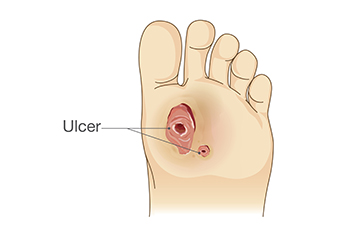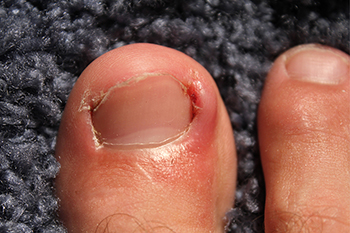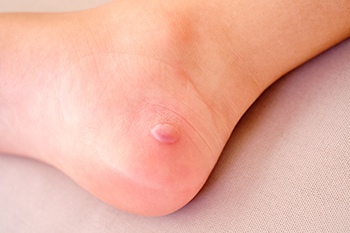Items filtered by date: February 2025
Stop Your Toenail Fungus
Understanding Diabetic Foot Wounds

A diabetic foot wound refers to an open sore or infection that occurs on the feet of people with diabetes. This condition often arises due to poor circulation, nerve damage, and high blood sugar levels, which impair the body’s ability to heal. The main causes include prolonged pressure on a certain area, trauma, and infections that can occur unnoticed due to lack of sensation. Symptoms may include redness, swelling, pain, and foul-smelling discharge. If left untreated, these wounds can lead to serious complications, such as gangrene. Proper care for diabetic foot wounds involves cleaning the area gently, dressing it regularly, and monitoring for signs of infection. Controlling blood sugar levels and maintaining good hygiene are essential in preventing further complications. If you have diabetes, it is strongly suggested that you are under the care of a podiatrist who can treat such foot wounds, and help you to manage this serious condition.
Wound care is an important part in dealing with diabetes. If you have diabetes and a foot wound or would like more information about wound care for diabetics, consult with Yacara Tabb, DPM from Optimum Foot Care. Our doctor will assess your condition and provide you with quality foot and ankle treatment.
What Is Wound Care?
Wound care is the practice of taking proper care of a wound. This can range from the smallest to the largest of wounds. While everyone can benefit from proper wound care, it is much more important for diabetics. Diabetics often suffer from poor blood circulation which causes wounds to heal much slower than they would in a non-diabetic.
What Is the Importance of Wound Care?
While it may not seem apparent with small ulcers on the foot, for diabetics, any size ulcer can become infected. Diabetics often also suffer from neuropathy, or nerve loss. This means they might not even feel when they have an ulcer on their foot. If the wound becomes severely infected, amputation may be necessary. Therefore, it is of the upmost importance to properly care for any and all foot wounds.
How to Care for Wounds
The best way to care for foot wounds is to prevent them. For diabetics, this means daily inspections of the feet for any signs of abnormalities or ulcers. It is also recommended to see a podiatrist several times a year for a foot inspection. If you do have an ulcer, run the wound under water to clear dirt from the wound; then apply antibiotic ointment to the wound and cover with a bandage. Bandages should be changed daily and keeping pressure off the wound is smart. It is advised to see a podiatrist, who can keep an eye on it.
If you have any questions, please feel free to contact our office located in Slidell, LA . We offer the newest diagnostic and treatment technologies for all your foot care needs.
Nail Growth and Ingrown Toenails

An ingrown toenail might seem minor at first, but when ignored, it can turn into a painful, swollen mess. It happens when the edge of the nail digs into the surrounding skin, often due to improper trimming, wearing tight shoes, or natural nail shape. At first, it might just be discomfort, but as the skin becomes irritated, redness, swelling, and even infection can develop. People who are on their feet all day, athletes, and those with thicker or curved nails are more prone to ingrown toenails. The biggest mistake that many people make is trying to treat it at home, which often worsens the problem. If you have a painful ingrown toenail, it is suggested that you see a podiatrist who can effectively treat this condition.
Ingrown toenails can become painful if they are not treated properly. For more information about ingrown toenails, contact Yacara Tabb, DPM of Optimum Foot Care. Our doctor can provide the care you need to keep you pain-free and on your feet.
Ingrown Toenails
Ingrown toenails occur when a toenail grows sideways into the bed of the nail, causing pain, swelling, and possibly infection.
Causes
- Bacterial infections
- Improper nail cutting such as cutting it too short or not straight across
- Trauma to the toe, such as stubbing, which causes the nail to grow back irregularly
- Ill-fitting shoes that bunch the toes too close together
- Genetic predisposition
Prevention
Because ingrown toenails are not something found outside of shoe-wearing cultures, going barefoot as often as possible will decrease the likeliness of developing ingrown toenails. Wearing proper fitting shoes and using proper cutting techniques will also help decrease your risk of developing ingrown toenails.
Treatment
Ingrown toenails are a very treatable foot condition. In minor cases, soaking the affected area in salt or antibacterial soaps will not only help with the ingrown nail itself, but also help prevent any infections from occurring. In more severe cases, surgery is an option. In either case, speaking to your podiatrist about this condition will help you get a better understanding of specific treatment options that are right for you.
If you have any questions please feel free to contact our office located in Slidell, LA . We offer the newest diagnostic and treatment technologies for all your foot and ankle needs.
What Causes Blisters on the Feet?

Blisters on the feet are small pockets of fluid that form as a protective response to friction, heat, or pressure. They commonly occur from wearing ill-fitting shoes, which cause rubbing, or during intense physical activities like running or hiking. Moisture from sweat can worsen friction, increasing the likelihood of blister formation. Other causes include burns, frostbite, or allergic reactions to footwear materials. Infections, such as athlete’s foot, may also trigger blistering, as can certain medical conditions like diabetes or eczema. Repeated stress in specific areas, like the ball of the foot or heel, makes these spots more prone to blisters. Proper footwear, moisture-wicking socks, and reducing friction with protective padding can help prevent blisters. If blisters become frequent, painful, or show signs of infection, it is strongly suggested that you see a podiatrist for a proper diagnosis and effective treatment.
Blisters are prone to making everyday activities extremely uncomfortable. If your feet are hurting, contact Yacara Tabb, DPM of Optimum Foot Care. Our doctor can provide the care you need to keep you pain-free and on your feet.
Foot Blisters
Foot blisters develop as a result of constantly wearing tight or ill-fitting footwear. This happens due to the constant rubbing from the shoe, which can often lead to pain.
What Are Foot Blisters?
A foot blister is a small fluid-filled pocket that forms on the upper-most layer of the skin. Blisters are filled with clear fluid and can lead to blood drainage or pus if the area becomes infected.
How Do Blisters Form?
Blisters on the feet are often the result of constant friction of skin and material, usually by shoe rubbing. Walking in sandals, boots, or shoes that don’t fit properly for long periods of time can result in a blister. Having consistent foot moisture and humidity can easily lead to blister formation.
Prevention & Treatment
It is important to properly care for the affected area in order to prevent infection and ease the pain. Do not lance the blister and use a Band-Aid to provide pain relief. Also, be sure to keep your feet dry and wear proper fitting shoes. If you see blood or pus in a blister, seek assistance from a podiatrist.
If you have any questions, please feel free to contact our office located in Slidell, LA . We offer the newest diagnostic and treatment technologies for all your foot care needs.
Common Running Foot Injuries and Relief Tactics

Running can lead to a variety of foot injuries, with some of the most common being plantar fasciitis, metatarsalgia, toenail damage, and peroneal tendonitis. Plantar fasciitis occurs when the tissue on the bottom of the foot becomes inflamed, often causing heel pain, especially in the morning. Metatarsalgia refers to pain in the ball of the foot, typically from excessive pressure or improper footwear. Toenail damage, such as bruising or loss, can result from tight shoes or repeated trauma during long runs. Peroneal tendonitis affects the tendons along the outside of the ankle and foot, leading to pain and swelling. To relieve these injuries, runners can benefit from rest, proper footwear, and targeted stretching exercises, in addition to gradually increasing mileage to allow the body time to heal. If you have sustained foot or ankle injuries from running, it is suggested that you contact a podiatrist who can offer effective relief tips, and guide on additional injury prevention methods.
Foot Pain
Foot pain can be extremely painful and debilitating. If you have a foot pain, consult with Yacara Tabb, DPM from Optimum Foot Care. Our doctor will assess your condition and provide you with quality foot and ankle treatment.
Causes
Foot pain is a very broad condition that could be caused by one or more ailments. The most common include:
- Bunions
- Hammertoes
- Plantar Fasciitis
- Bone Spurs
- Corns
- Tarsal Tunnel Syndrome
- Ingrown Toenails
- Arthritis (such as Gout, Rheumatoid, and Osteoarthritis)
- Flat Feet
- Injury (from stress fractures, broken toe, foot, ankle, Achilles tendon ruptures, and sprains)
- And more
Diagnosis
To figure out the cause of foot pain, podiatrists utilize several different methods. This can range from simple visual inspections and sensation tests to X-rays and MRI scans. Prior medical history, family medical history, and any recent physical traumatic events will all be taken into consideration for a proper diagnosis.
Treatment
Treatment depends upon the cause of the foot pain. Whether it is resting, staying off the foot, or having surgery; podiatrists have a number of treatment options available for foot pain.
If you have any questions, please feel free to contact our office located in Slidell, LA . We offer the newest diagnostic and treatment technologies for all your foot care needs.

